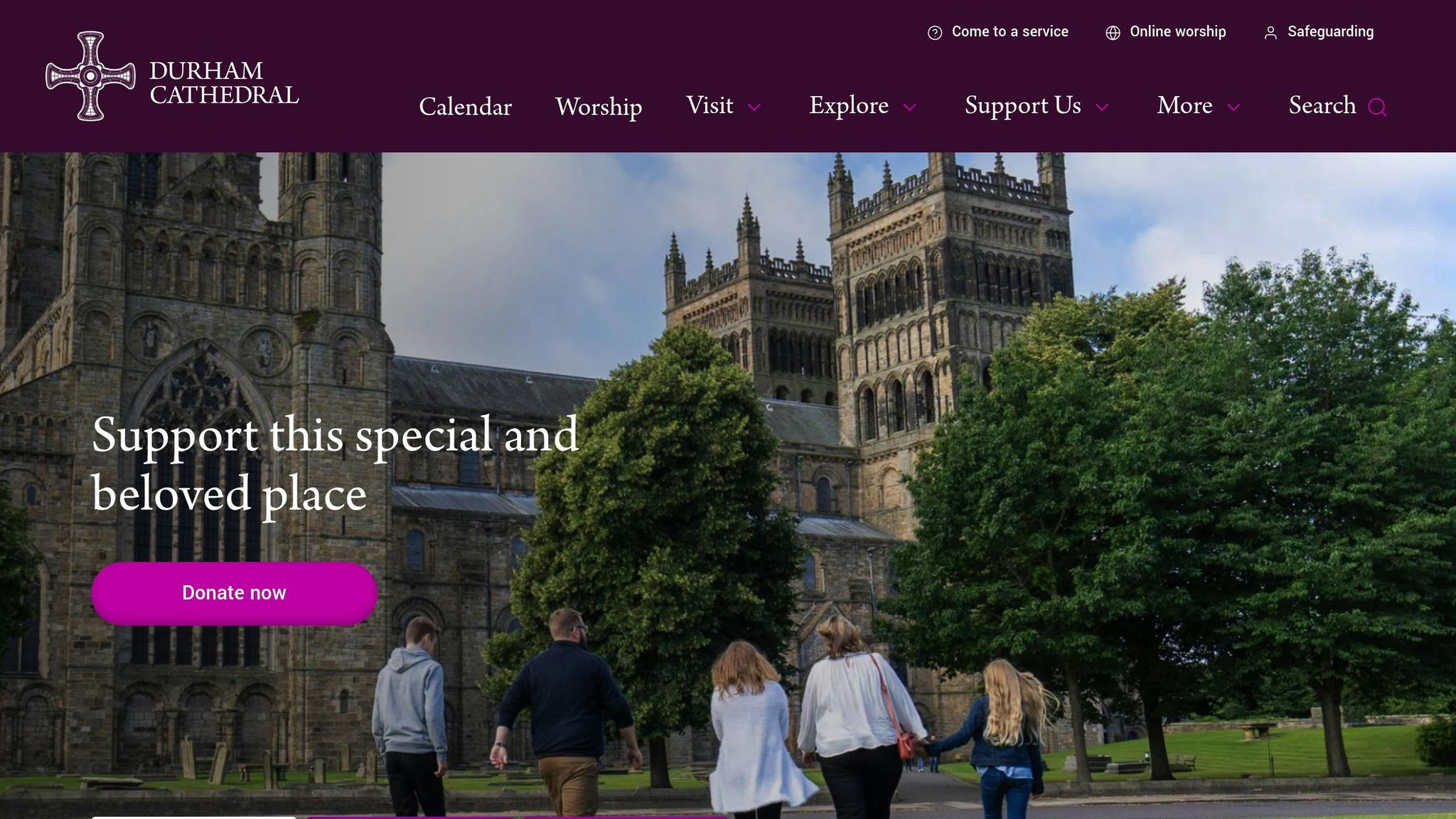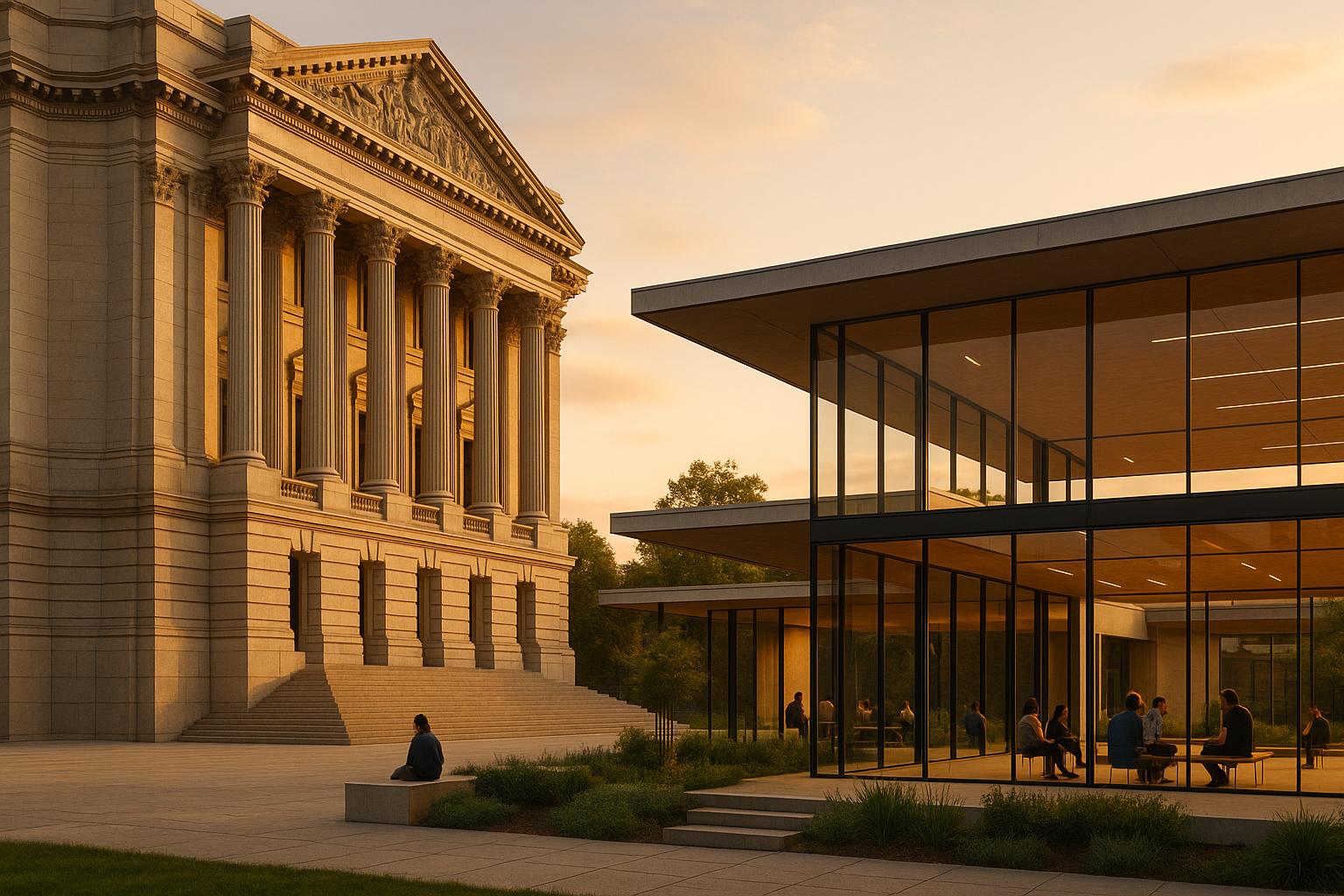Chapter houses are meeting spaces found in monasteries, cathedrals, and collegiate churches. Historically, they served as the administrative and spiritual centers of monastic life. These spaces were used for daily gatherings, where monks managed tasks, read from the Rule of St. Benedict, and addressed community matters. Over time, chapter houses also became venues for major events, including royal meetings and political decisions.
Key highlights:
- Purpose: Daily meetings, spiritual reflection, task management, and ceremonies.
- Historical Significance: Used for governance, intellectual discussions, and hosting important events like the signing of the Channel Tunnel agreement.
- Architecture: Evolved from simple Romanesque designs to ornate Gothic styles with ribbed vaults and stained glass.
- Examples: Westminster Abbey, York Minster, and Salisbury Cathedral chapter houses showcase their architectural evolution and historical importance.
These spaces reflect their era's priorities, blending functionality with design, and remain symbols of unity and governance in both religious and civic contexts.
Functions and Roles of Chapter Houses
Administrative and Spiritual Functions
Chapter houses were at the heart of monastic life, blending administrative duties with spiritual practices. These spaces were where monks convened daily with their abbot or abbess for "holding chapter" meetings. During these gatherings, a passage from the Rule of St. Benedict was read, faults were acknowledged and addressed, and tasks were assigned. It was also a time for monks to be held accountable for any transgressions, while senior officials provided updates on the monastery's operations. A 1344 decree by Pope Benedict XII formalized these daily meetings for monasteries with more than six members, underscoring their importance. These administrative routines often intertwined with ceremonial traditions, making the chapter house a central hub of monastic activity.
Ceremonial Uses
The chapter house also held a sacred role in marking significant milestones in monastic life. Admission ceremonies and the taking of vows were pivotal events conducted in these halls, with new members pledging their commitments in front of the entire community. When a monk passed away, the chapter house became a place for communal mourning, as his body was brought there to rest before burial, accompanied by a memorial service.
Disciplinary practices took on a ceremonial aspect as well. Public meetings were followed by private sessions - attended by all members except novices - where monks could either confess their own shortcomings or accuse others of breaking monastic rules. These sessions reinforced the chapter house's role as a place of accountability and reflection.
Historical Uses
Over time, chapter houses extended their influence beyond monastic rituals, becoming significant venues for public and political activities. They hosted royal audiences, ecclesiastical courts, and synods, transforming into centers of governance and intellectual exchange . For instance, Westminster Abbey's chapter house regularly served as the meeting place for the King's Court, which eventually evolved into Parliament.
These spaces were also vital for preserving and sharing knowledge. Monks gathered in chapter houses to study, copy, and discuss religious, philosophical, and literary works, ensuring the survival of key texts through the centuries. Additionally, chapter houses functioned as reception areas for esteemed visitors, including nobility, church leaders, and foreign ambassadors, and as venues for addressing matters of communal importance . Their multifaceted roles highlight their lasting significance in both monastic and broader societal contexts.
Architectural Features of Chapter Houses
Common Layouts and Locations
Chapter houses were typically positioned on the eastern wing of the cloister, adjacent to the church. This location reflected their importance within the monastery, serving as a secondary yet central hub. Since the east wing was often built immediately after the church, the chapter house's placement underscored its significance as the second most essential structure in monastic life. Often centrally located within the east wing, it provided easy access to both the church and the monks' living quarters. This strategic positioning ensured all residents could readily attend the daily meetings required by monastic rules.
The interiors featured built-in stone benches arranged around an open central area, creating space for speakers and ceremonies. These designs ensured the chapter house could accommodate the entire monastic community.
This practical layout laid the groundwork for stylistic advancements as architectural techniques progressed.
Architectural Styles and Decoration
The design of chapter houses evolved alongside medieval architecture, reflecting the changing priorities and aesthetics of the time.
Romanesque chapter houses (10th–12th centuries) were straightforward in design, often rectangular with solid walls, round arches, and barrel vaults. Window openings were sparse, prioritizing structural stability over decoration.
By the Gothic period (12th–15th centuries), chapter houses embraced more intricate designs. They featured ribbed vaulting, soaring ceilings, larger windows, and elaborate ornamentation. Vaulted roofs became standard, and by the late Middle Ages, many chapter houses incorporated large glazed windows with detailed tracery and stained glass that conveyed theological themes. Triple entrances, often richly adorned, became a common feature. These changes not only enhanced the aesthetic appeal but also allowed more natural light, making the spaces practical for reading and gatherings.
| Feature | Romanesque (10th–12th centuries) | Gothic (12th–15th centuries) |
|---|---|---|
| Walls | Solid, simple | More intricate, with larger openings |
| Arches | Round | Pointed |
| Vaulting | Barrel vaults | Ribbed vaulting |
| Windows | Small, limited openings | Large, with tracery and stained glass |
| Ornamentation | Minimal | Elaborate carvings and decorative details |
These stylistic shifts illustrate the architectural diversity of chapter houses and their adaptability to evolving trends.
Examples of Chapter Houses
Several chapter houses stand out as remarkable examples of their kind. Westminster Abbey’s 13th-century polygonal chapter house features intricate vaulting and was not only a religious space but also hosted meetings of the House of Commons until Henry VIII’s reign .
York Minster’s chapter house, built between the 13th and 14th centuries, is renowned for its exquisite carvings and stained glass. Meanwhile, Durham Cathedral’s chapter house tells a story of adaptation. Its original structure was partially demolished in 1796 due to challenges in heating the large space, which the 18th-century clergy found impractical. The current structure is a reconstruction completed in 1895.
Other noteworthy examples include the Chapter House of Salisbury Cathedral, celebrated for its intricate stone carvings and vibrant stained-glass windows, and Wells Cathedral’s Chapter House, which boasts an impressive collection of medieval sculptures and detailed architectural embellishments.
Role in Monastic Life
Connection to Daily Life
Chapter houses were at the core of monastic life, seamlessly woven into the monks' daily routines. Each morning, the community gathered in these spaces to read the Rule of St. Benedict, a text that outlined the principles guiding their way of life.
Beyond spiritual reflection, chapter houses played a key role in administrative matters. During these daily meetings, monks received their weekly assignments, reviewed correspondence, and listened to reports from monastery officials. The abbot took this opportunity to address the community, delegate tasks, and provide spiritual guidance.
Discipline was also a central function of the chapter house. Monks participated in private sessions to confess their failings or report breaches of rules, with the abbot overseeing these matters and determining any necessary consequences. Punishments, when required, were often announced or enacted immediately. To maintain order, strict protocols governed these discussions - speaking clearly, listening silently, and showing deference to the abbot ensured the meetings stayed purposeful and effective.
This structured routine not only kept monastic life organized but also established a foundation for the chapter house's enduring symbolic significance.
Symbolism and Legacy
Chapter houses stood as powerful symbols of community, discipline, and spiritual unity. They were spaces where monks came together as equals before God and their superior, embodying the essence of monastic tradition.
The architectural design of chapter houses reflected their importance. Typically positioned at the heart of a monastery, these spaces symbolized the intersection of the monks' spiritual and practical lives, emphasizing their central role in the community.
Over the centuries, chapter houses became the setting for significant monastic events. They hosted ceremonies such as the election of abbots, the admission of monks to their vows, and decisions about establishing new foundations. These formal gatherings often had lasting impacts. Their influence even extended beyond monastic walls; Westminster Abbey's chapter house, for instance, once served as a meeting place for the King’s Court, a precursor to Parliament.
Modern monastic communities continue to honor these traditions. The Chapter Room of Our Lady of Clear Creek Abbey, completed in 2023, now serves a thriving monastic community, providing a space for meetings, spiritual discussions, and official reports. Reflecting on its purpose, Brother Philip Anderson, Abbot of Our Lady of Clear Creek Abbey, remarked:
"As with the abbatial church, it is from this room that we hope to move someday to the Heavenly Jerusalem, the place of the 'vision of peace.'"
The symbolic importance of chapter houses also resonates in contemporary settings. In 1986, Canterbury Cathedral's chapter house hosted the signing of the agreement to construct the Channel Tunnel between Britain and France. This historic event, attended by Prime Minister Margaret Thatcher and President François Mitterrand, showcased how these medieval spaces continue to serve as fitting backdrops for decisions of great consequence.
sbb-itb-1be9014
Conclusion
Key Points
Chapter houses were central to monastic life, serving as both administrative and spiritual hubs. Monks met daily in these spaces to read from the Rule of St. Benedict, manage community affairs, and maintain religious discipline. Their placement within monastery complexes and their varied layouts - whether polygonal, rectangular, or circular - highlighted their dual role in governance and spiritual reflection.
These spaces symbolized unity and hierarchy within monastic communities. They hosted routine meetings and were the setting for critical decisions about leadership and spiritual direction. Over time, their designs evolved to meet changing needs, while still preserving their core functions.
The influence of chapter houses extends beyond their original purpose. The reconstructed Chapter House of Durham Cathedral, completed in 1895, showcases their enduring architectural and cultural significance. Their legacy continues to inspire curiosity about their role in history and their impact on design.
Explore More with Architecture Helper

If this topic sparks your interest, Architecture Helper offers a gateway to dive deeper into the design and history of chapter houses. These spaces, with their rich architectural evolution, reflect the craftsmanship and values of their time. From the straightforward forms of early Norman designs to the elaborate details of Gothic architecture, each chapter house tells a story.
Architecture Helper allows users to explore this legacy through shared photographs and instant analysis. This resource connects architecture enthusiasts with the principles and influences behind these historic spaces, bridging the gap between the past and the present.
Durham Cathedral's Chapter House - by Cathedral Guide David Hunt

FAQs
How did chapter houses transition from Romanesque to Gothic architecture?
Chapter houses transitioned from the robust and straightforward Romanesque style - characterized by thick walls, rounded arches, and small windows - to the more elaborate and graceful Gothic design. Gothic chapter houses stood out with their pointed arches, ribbed vaults, and large stained-glass windows, creating spaces that were taller, brighter, and far more open.
This shift was made possible by advances in engineering and a growing focus on height and light, which symbolized spiritual ambition and progress during the Gothic era. These architectural innovations not only improved structural integrity but also mirrored the artistic and cultural shifts of the period.
What were chapter houses, and why were they important in history?
Chapter houses played a key role in the daily lives of monastic and cathedral communities, serving as hubs for both religious and political activities. Within these spaces, clergy would hold meetings to address important issues, make decisions, and hear readings of monastic rules. These gatherings were crucial for upholding the governance and spiritual discipline of the community.
Beyond their religious purpose, chapter houses often held a political role as well. Take Westminster Abbey's chapter house, for instance - it was used for early parliamentary meetings and other civic events, blending religious influence with governance. This dual purpose highlights their historical importance as places where spiritual and societal matters intersected.
How do modern monastic communities use chapter houses, and are they still as important today?
Modern monastic communities still rely on chapter houses as vital spaces for gatherings, spiritual contemplation, and collective decision-making. These rooms play a key role in maintaining a sense of togetherness and shared mission among members.
While the architectural designs and practical functions of chapter houses may shift with time, their primary role as hubs for assembly and spiritual connection remains unchanged. They continue to represent tradition, community, and the essence of monastic life.


